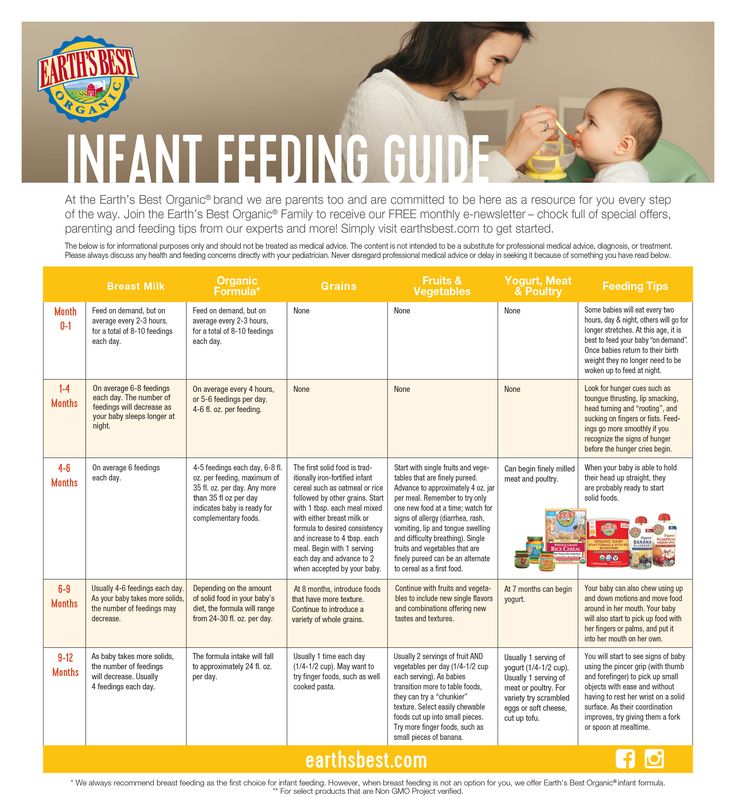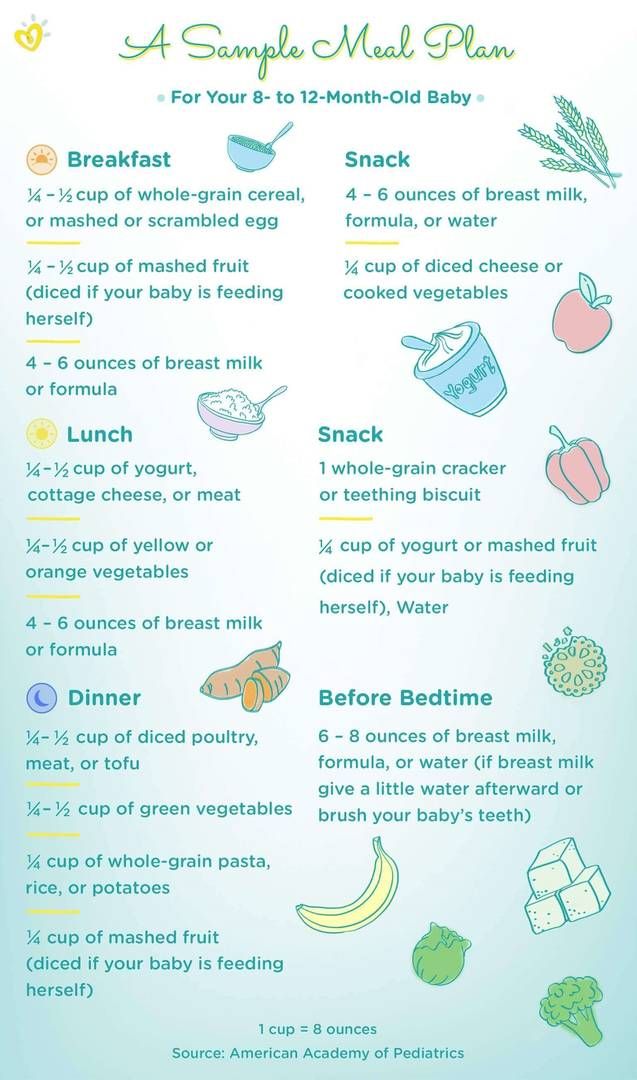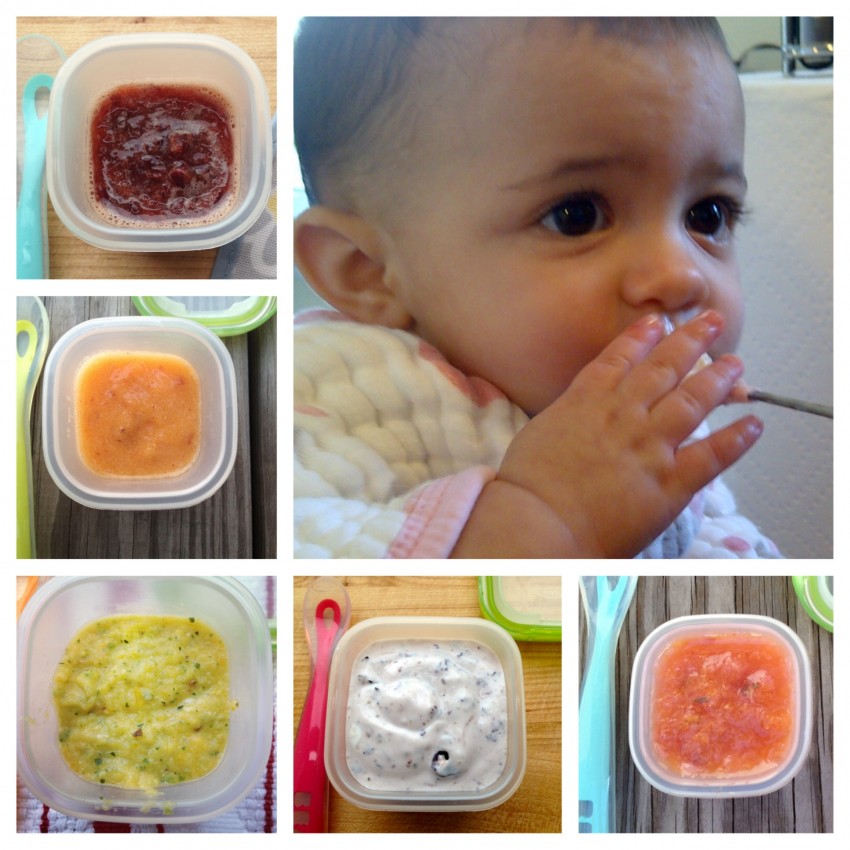Start feeding baby solids
When, What, and How to Introduce Solid Foods | Nutrition
For more information about how to know if your baby is ready to starting eating foods, what first foods to offer, and what to expect, watch these videos from 1,000 Days.
The Dietary Guidelines for Americans and the American Academy of Pediatrics recommend children be introduced to foods other than breast milk or infant formula when they are about 6 months old. Introducing foods before 4 months old is not recommended. Every child is different. How do you know if your child is ready for foods other than breast milk or infant formula? You can look for these signs that your child is developmentally ready.
Your child:
- Sits up alone or with support.
- Is able to control head and neck.
- Opens the mouth when food is offered.
- Swallows food rather than pushes it back out onto the chin.
- Brings objects to the mouth.
- Tries to grasp small objects, such as toys or food.
- Transfers food from the front to the back of the tongue to swallow.
What Foods Should I Introduce to My Child First?
The American Academy of Pediatrics says that for most children, you do not need to give foods in a certain order. Your child can begin eating solid foods at about 6 months old. By the time he or she is 7 or 8 months old, your child can eat a variety of foods from different food groups. These foods include infant cereals, meat or other proteins, fruits, vegetables, grains, yogurts and cheeses, and more.
If your child is eating infant cereals, it is important to offer a variety of fortifiedalert icon infant cereals such as oat, barley, and multi-grain instead of only rice cereal. Only providing infant rice cereal is not recommended by the Food and Drug Administration because there is a risk for children to be exposed to arsenic. Visit the U.S. Food & Drug Administrationexternal icon to learn more.
How Should I Introduce My Child to Foods?
Your child needs certain vitamins and minerals to grow healthy and strong.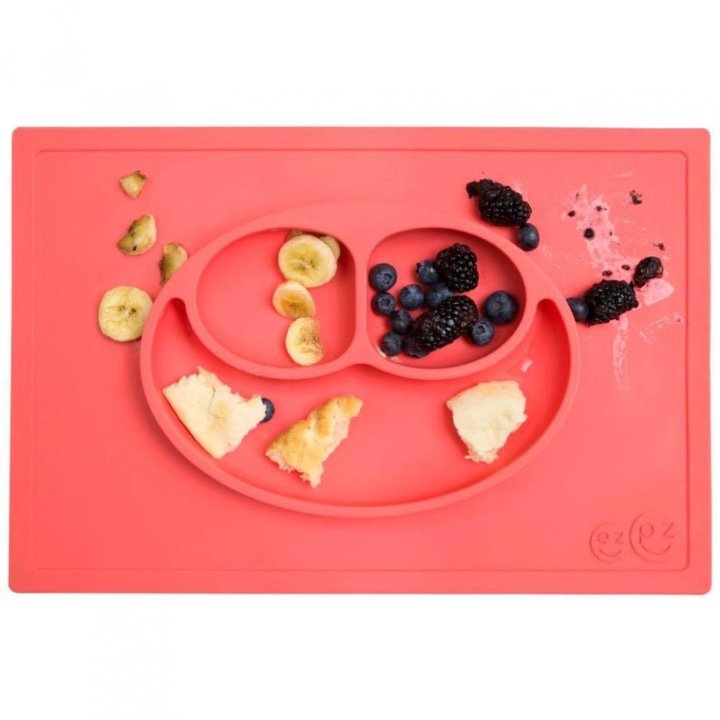
Now that your child is starting to eat food, be sure to choose foods that give your child all the vitamins and minerals they need.
Click here to learn more about some of these vitamins & minerals.
Let your child try one single-ingredient food at a time at first. This helps you see if your child has any problems with that food, such as food allergies. Wait 3 to 5 days between each new food. Before you know it, your child will be on his or her way to eating and enjoying lots of new foods.
Introduce potentially allergenic foods when other foods are introduced.
Potentially allergenic foods include cow’s milk products, eggs, fish, shellfish, tree nuts, peanuts, wheat, soy, and sesame. Drinking cow’s milk or fortified soy beverages is not recommended until your child is older than 12 months, but other cow’s milk products, such as yogurt, can be introduced before 12 months. If your child has severe eczema and/or egg allergy, talk with your child’s doctor or nurse about when and how to safely introduce foods with peanuts.
How Should I Prepare Food for My Child to Eat?
At first, it’s easier for your child to eat foods that are mashed, pureed, or strained and very smooth in texture. It can take time for your child to adjust to new food textures. Your child might cough, gag, or spit up. As your baby’s oral skills develop, thicker and lumpier foods can be introduced.
Some foods are potential choking hazards, so it is important to feed your child foods that are the right texture for his or her development. To help prevent choking, prepare foods that can be easily dissolved with saliva and do not require chewing. Feed small portions and encourage your baby to eat slowly. Always watch your child while he or she is eating.
Here are some tips for preparing foods:
- Mix cereals and mashed cooked grains with breast milk, formula, or water to make it smooth and easy for your baby to swallow.
- Mash or puree vegetables, fruits and other foods until they are smooth.
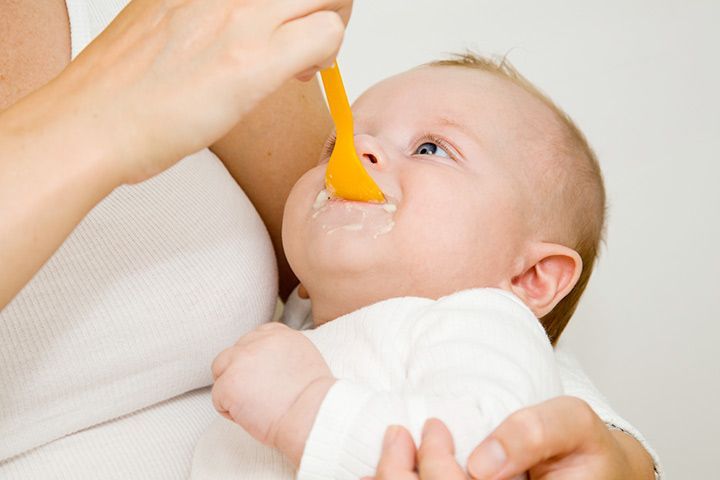
- Hard fruits and vegetables, like apples and carrots, usually need to be cooked so they can be easily mashed or pureed.
- Cook food until it is soft enough to easily mash with a fork.
- Remove all fat, skin, and bones from poultry, meat, and fish, before cooking.
- Remove seeds and hard pits from fruit, and then cut the fruit into small pieces.
- Cut soft food into small pieces or thin slices.
- Cut cylindrical foods like hot dogs, sausage and string cheese into short thin strips instead of round pieces that could get stuck in the airway.
- Cut small spherical foods like grapes, cherries, berries and tomatoes into small pieces.
- Cook and finely grind or mash whole-grain kernels of wheat, barley, rice, and other grains.
Learn more about potential choking hazards and how to prevent your child from choking.
Top of Page
Helpful Resources | Nutrition | CDC
If you would like more information on topics related to feeding your baby or toddler, here are some resources:
General
CDC’s Infant and Toddler Nutrition microsite syndication
CDC offers a free Web Content Syndication service that gives public health partners the opportunity to syndicate CDC content directly to their sites without having to monitor or copy updates.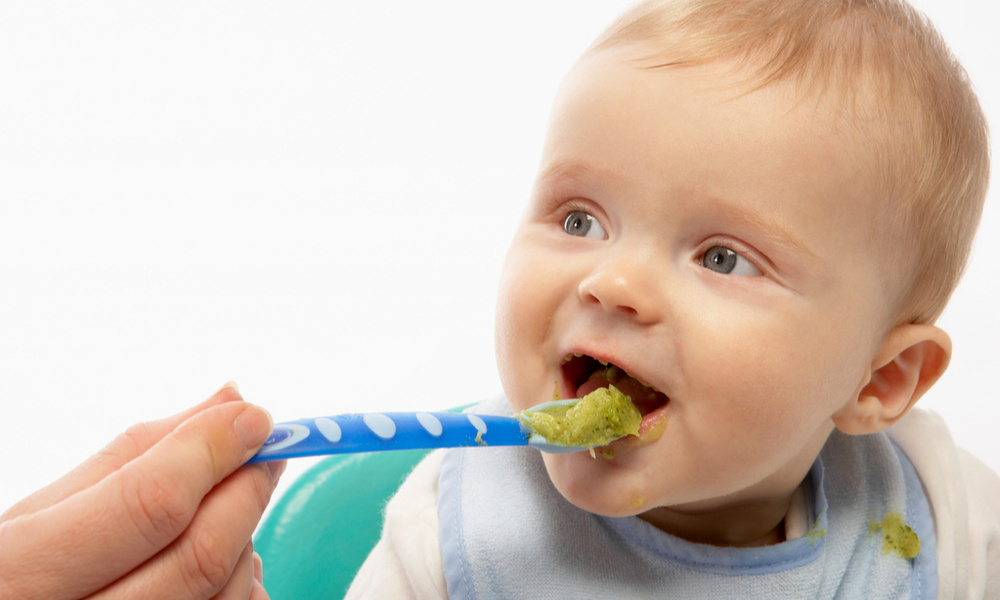 To search the CDC infant and toddler nutrition website available for syndication as well as other resources you can share, visit the CDC Public Health Media Library and browse or search for “infant and toddler nutrition”. Learn more about content syndication and how to add CDC syndicated content on your site.
To search the CDC infant and toddler nutrition website available for syndication as well as other resources you can share, visit the CDC Public Health Media Library and browse or search for “infant and toddler nutrition”. Learn more about content syndication and how to add CDC syndicated content on your site.
CDC’s Child and Teen Resources
This collection of resources provides parents and caregivers, health care providers, and partners with tools and information to help children and teens maintain a healthy weight and prevent obesity.
CDC’s Child Development Positive Parenting Tips (Infants)
This CDC website provides information about infants’ development, as well as tips for positive parenting and promoting the safety and health of infants.
CDC’s Learn the Signs. Act Early.
This website includes tools to track children’s milestones and resources about children’s development.
CDC’s Parent Information
This CDC website provides resources and information on pregnancy, infants and toddlers, children, and teens.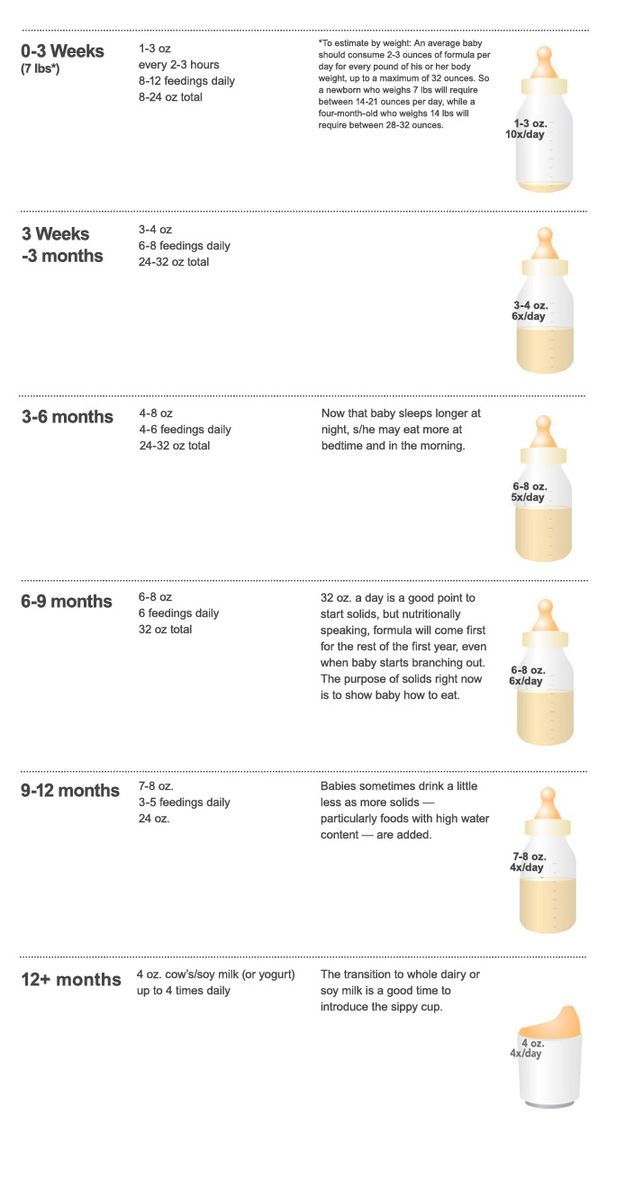 Learn how to handle common parenting challenges through interactive activities, videos, and more. Healthcare professionals and researchers can also find information on children’s health and safety.
Learn how to handle common parenting challenges through interactive activities, videos, and more. Healthcare professionals and researchers can also find information on children’s health and safety.
CDC’s Division of Oral Health
Tooth decay (cavities) is one of the most common chronic diseases of childhood in the United States. Untreated tooth decay can cause pain and infections that may lead to problems with eating, speaking, playing, and learning. CDC’s Division of Oral Health provides information on what parents and caregivers can do to ensure good oral health for your child.
Dietary Guidelines for Americans 2020–2025 pdf icon[PDF-30.6MB]external icon
These guidelines provide science-based advice for Americans on what to eat and drink to promote health, reduce chronic disease, and meet nutrient needs. The 2020–2025 edition provides recommendations for all life stages, including infants and toddlers.
Feeding Guidelines for Infants and Young Toddlers: A Responsive Parenting Approachexternal icon
This report presents recommendations for promoting healthy nutrition and feeding patterns for infants and toddlers from birth to 24 months, with an emphasis on dietary quality, portion sizes, and mealtime environment.
Healthy Childrenexternal icon
This website was developed by the American Academy of Pediatrics for parents. It features thousands of articles in English and Spanish on children’s health and safety, as well as interactive tools.
United States Department of Agriculture Special Supplemental Nutrition Program for Women, Infants, and Children (WIC)external icon
The WIC Program provides support to low-income pregnant, postpartum, and breastfeeding women, babies, and children up to age 5. WIC provides nutritious foods, information on healthy eating, breastfeeding promotion and support, and referrals to health care.
United States Department of Agriculture Supplemental Nutrition Assistance Program (SNAP)external icon
SNAP provides benefits to low-income individuals and families and provides economic benefits to communities.
Feeding and Beverage Recommendationsexternal icon
Healthy Eating Research, a national program of the Robert Wood Johnson Foundation, offers science-based recommendations for parents and caregivers. Tips are available for feeding children from birth through 24 monthsexternal icon and beverages for children from birth through 5 yearsexternal icon. Tips for older children are also available.
Tips are available for feeding children from birth through 24 monthsexternal icon and beverages for children from birth through 5 yearsexternal icon. Tips for older children are also available.
U.S. Food and Drug Administration (FDA) and Environmental Protection Agency’s (EPA) Advice About Eating Fishexternal icon
The U.S. FDA and EPA provide advice regarding eating fish. This advice can help people make informed choices when it comes to the types of fish that are nutritious and safe to eat. It is especially important for those who might become pregnant, who are pregnant, or who are breastfeeding, as well as for parents and caregivers who are feeding children. This advice supports the recommendations of the Dietary Guidelines for Americans.
Top of Page
Breastfeeding
CDC’s Breastfeeding Information
CDC’s Division of Nutrition, Physical Activity, and Obesity (DNPAO) is committed to increasing breastfeeding rates throughout the United States. CDC provides information for public health professionals and others to help support breastfeeding mothers, such as managing breastfeeding during various maternal and infant illnesses and conditions, any precautions for vaccines during breastfeeding, and recommendations for proper storage and handling of expressed human milk.
CDC provides information for public health professionals and others to help support breastfeeding mothers, such as managing breastfeeding during various maternal and infant illnesses and conditions, any precautions for vaccines during breastfeeding, and recommendations for proper storage and handling of expressed human milk.
International Lactation Consultant Association (ILCA)external icon
ILCA is the member association for professionals who care for breastfeeding families. ILCA’s “Find a Lactation Consultant Directory” can help you find a lactation consultant to get the breastfeeding support you need.
United States Lactation Consultant Association (USLCA)external icon
USLCA is a professional association for International Board Certified Lactation Consultants (IBCLCs) and other health care professionals who care for breastfeeding families. USLCA’s “Find an IBCLC” can help you find a lactation consultant to get the breastfeeding support you need.
WIC, the Special Supplemental Nutrition Program for Women, Infants, and Children—Breastfeeding Support external icon
The United States Department of Agriculture Special Supplemental Nutrition Program for Women, Infants, and Children (WIC) Breastfeeding Support website includes resources for expectant and current mothers about breastfeeding, overcoming common challenges, and thriving to make breastfeeding work for their families.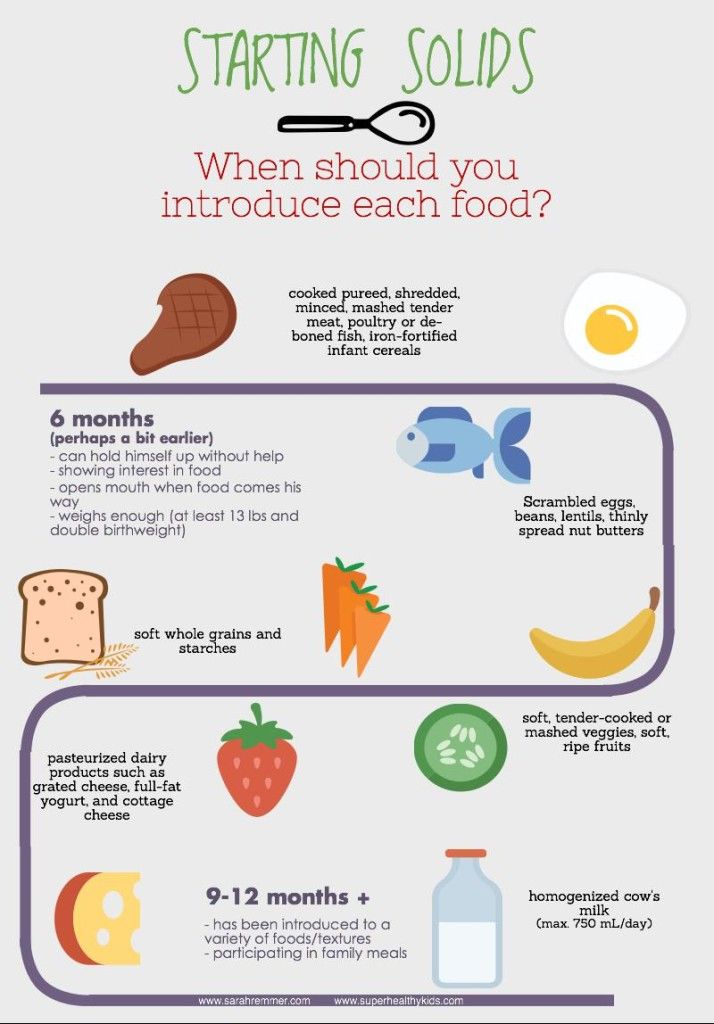
La Leche League USAexternal icon
La Leche League USA helps mothers to breastfeed through mother-to-mother support, encouragement, information, and education and promotes a better understanding of breastfeeding as an important element in the healthy development of the baby and mother.
Office on Women’s Healthexternal icon
The Office on Women’s Health’s vision is for all women and girls to achieve the best possible health outcomes. They provide information on breastfeeding to help women make infant feeding decisions and to guide mothers through the breastfeeding process.
Top of Page
Infant Formula
Questions & Answers for Consumers Concerning Infant Formulaexternal icon
The U.S. Food & Drug Administration regulates infant formula and has a list of questions and answers about infant formula.
Infant Formula Do’s and Don’tsexternal icon
The U.S. Food and Drug Administration provides information on infant formula preparation and storage, as well as other tips on how to keep infant formula safe.
Top of Page
Food Safety
Food Safety Concerns for Children Under Fiveexternal icon
Food safety is particularly important for young children. Foodsafety.gov provides information on safely preparing food for your child.
Top of Page
Meal Time
Fruits & Veggies—Have a Plant Movementexternal icon
A resource designed to help spread the word about the health benefits of adding more fruits and veggies to your diet.
USDA MyPlate Kitchenexternal icon
This online tool features a large collection of recipes and resources to support building healthy and budget-friendly meals. Site features include:
- Extensive search filters on cuisine, cooking equipment, nutrition content, and more.
- Detailed nutrition information.
- Cookbooks to browse and download or build your own.
- Recipe star ratings, review comments, and sharing on social networks.
Video Series on How to Introduce Solid Foods
1,000 Days has developed helpful videos about introducing solid foods to your baby. Topics include:
Topics include:
- Is your baby ready to start eating foods?
- What is a good first food for your baby?
- What to expect when introducing first foods
- How much should I feed my baby?
- How to win at mealtimeexternal icon
- What foods should my baby avoid?
- What should your baby eat in the first year?
Top of Page
Vitamins and Minerals
Vitamin and Mineral Fact Sheetsexternal icon
The National Institutes of Health’s Office of Dietary Supplements has fact sheets for consumers and health professionals about vitamins, minerals, and dietary supplements.
Top of Page
Introducing Solid Food: Why, When, What and How
Introducing Solid Food: Why Babies Need It
As babies grow older, the need for solid food arises, from which the body will receive enough iron and other nutrients necessary for growth and development.
During the first six months, the baby's body uses the iron stored in the womb.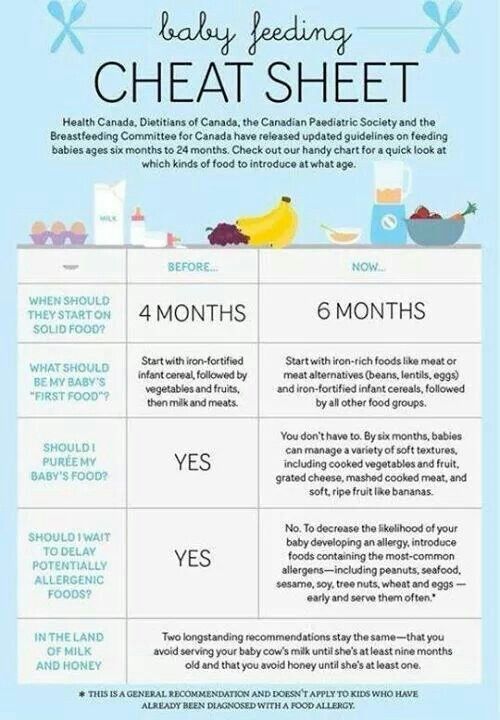 Some iron also comes from breast milk and/or formula. But as the baby grows, the reserves of this substance in the body decrease. And the iron that a child receives from breast milk or formula is already not enough at the age of about six months.
Some iron also comes from breast milk and/or formula. But as the baby grows, the reserves of this substance in the body decrease. And the iron that a child receives from breast milk or formula is already not enough at the age of about six months.
Through the introduction of solid foods, the child also learns to eat, gets to know new tastes and textures of different foods. At the same time, he develops teeth and jaws, and he also acquires skills that will later be needed for language development.
Signs it's time to introduce solid foods
You will know when it's time to introduce solid foods by how your baby develops and behaves.
Your child is ready for solid food if:
- holds head and neck well and can sit upright with support
- shows interest in food - for example, looking at the contents of your plate
- reaching for your food
- opens his mouth when you offer him food from a spoon.
Most children show these signs by about six months, but in general everyone is individual.
It is not recommended to introduce solid foods before four months of age.
If your baby is about seven months old and hasn't started solid foods yet, you can talk to a nurse or pediatrician.
The best time to offer solid food to your baby is when you and he are in a good mood for the first time.
He is also more likely to try new foods after breast milk or formula. The fact is that when a child is really hungry, he only wants milk or formula, because he knows that he will be satisfied. At the same time, there will still be room for other food in his tummy.
Over time, you will learn to tell if your baby is hungry or full, wants to try something or is tired.
Your child is hungry, if:
- brightens up when he sees you cooking for him
- leans towards you while sitting in a highchair
- opens its mouth when you are about to feed it.
Your child no longer wants to eat if:
- turns away
- loses interest or gets distracted
- repels spoon
- purses his lips.
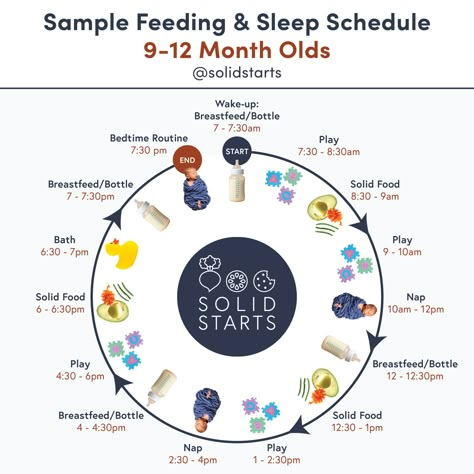
In what portions should the new food be introduced to the child? Start with 1-2 teaspoons and increase according to your baby's appetite. By 12 months, he should be eating about three small meals a day, plus breast milk or formula.
Consistency of solid food
The first solid food can be smooth, pureed or in soft pieces , depending on your baby's preference. Then the child can quickly move on to finely chopped, and then just to finely chopped foods.
The child needs food of various consistencies. This will help him learn to chew, and chewing, in turn, contributes to the development of speech. It also encourages the child to learn to eat on his own and will prevent eating problems as he develops.
By 12 months, the baby should already be eating the same as the rest of the family. You may have to cut some foods into smaller pieces, and boil the vegetables well.
Do not leave the child unattended while eating, make sure that he does not choke.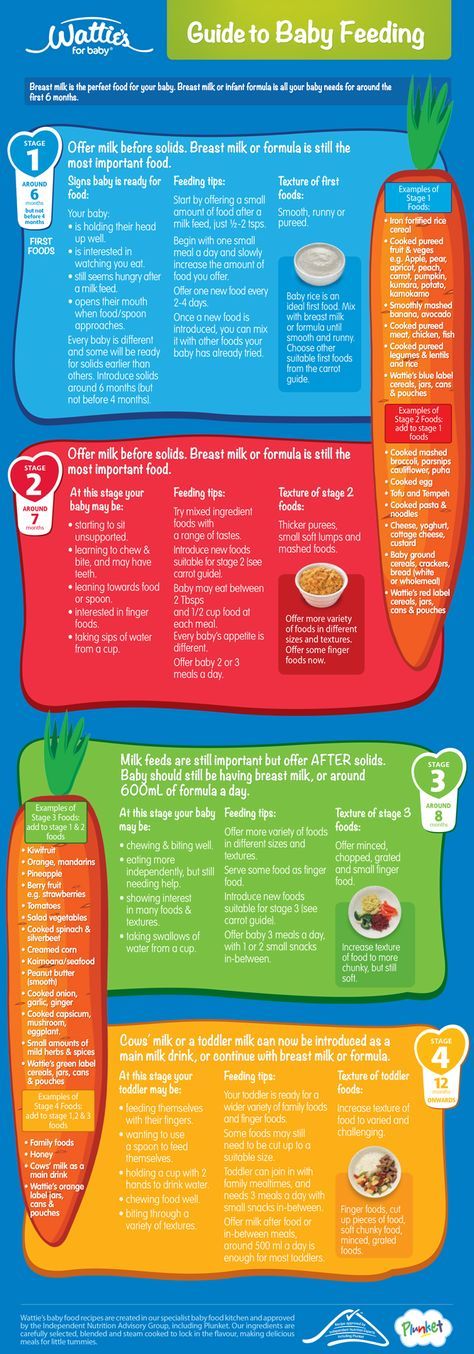 Be especially careful with foods such as nuts and small-boned meats, as they are easy to choke on. If the child can already move around, try to seat him while eating. If you sit next to each other while the baby is eating, he will most likely sit more quietly.
Be especially careful with foods such as nuts and small-boned meats, as they are easy to choke on. If the child can already move around, try to seat him while eating. If you sit next to each other while the baby is eating, he will most likely sit more quietly.
Types of foods when introducing solid foods
The child will be happy to try any new food, so there is no need to prepare something “special” for him.
You can introduce solid foods in any order, as long as you include iron-rich foods and cook foods of the right consistency.
Foods rich in iron include:
- iron-fortified baby cereals
- minced meat, poultry and fish
- tofu and legumes, cooked
- mashed or boiled eggs (do not give raw or soft-boiled eggs).
Iron-rich foods can be supplemented with other healthy foods:
- vegetables such as boiled potatoes, carrots or green vegetables such as broccoli
- fruit - e.
 g. banana, apple, melon or avocado
g. banana, apple, melon or avocado - cereals - e.g. oats, bread, rice and pasta
- Dairy products such as yogurt and full fat cheese.
These products can be combined as there is no need to administer only one product at a time. By offering your child a variety of foods, you will allow him to try a variety of new tastes and get a lot of nutrients.
With our solid food introduction tips, you can get your child interested in new foods and make the eating process smoother and playful.
Breast milk and formula when introducing solid food
Continue breastfeeding or formula until at least 12 months while introducing solid food.
If you are unsure if your baby is getting the right amount of milk once solids are introduced, pay attention to his behavior.
For example, if a child has eaten a lot of solid food and is not getting enough or is not getting enough milk, the daily milk feeds may need to be made less frequent but longer. If the baby does not want to eat solid food, he may have had too much milk. This may be a signal that portions of milk should be reduced.
If the baby does not want to eat solid food, he may have had too much milk. This may be a signal that portions of milk should be reduced.
By about nine months of age, babies usually develop enough chewing and swallowing skills to eat solid foods before milk, not after.
Solid food does not replace breast milk or formula. If the transition to solid foods instead of milk and/or formula occurs too quickly, a child may miss an important milestone in their diet.
Water administration
At the age of six months, the child may be offered chilled boiled water in a cup during meals or at other times. This is to help your baby learn to drink from a cup, but at this age, he still doesn't need liquids other than breast milk or formula. When the child is one year old, he can be offered fresh tap water without boiling.
Foods and drinks to avoid
Some foods should not be given to children under a certain age:
- honey under 12 months to avoid the risk of infant botulism
- raw eggs, soft-boiled eggs, and products containing raw eggs, such as homemade mayonnaise, up to 12 months - bacteria in raw eggs may be harmful to infants
- skim milk products up to two years
- Whole nuts and similar hard foods up to three years - due to risk of choking.
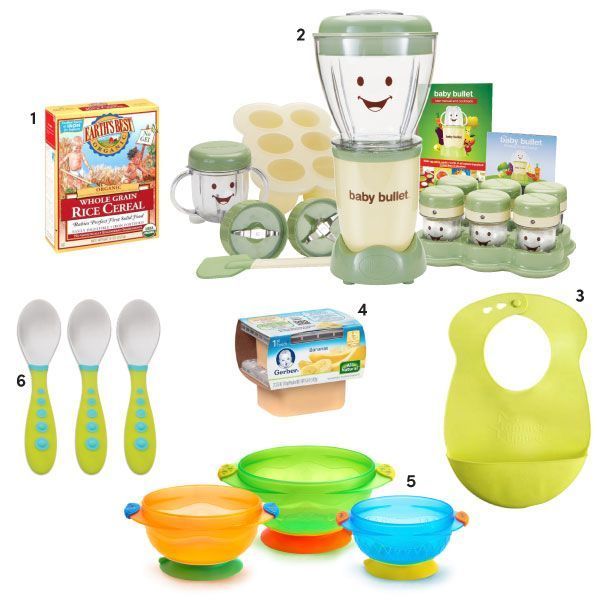
Also, up to a certain age, children should not be given certain drinks :
- pasteurized whole cow's milk as a main drink up to 12 months
- soy, goat and sheep milk up to two years (fortified soy products may be given up to two years)
- rice, oatmeal, almond or coconut milk up to two years of age, unless advised otherwise by a pediatrician or nurse
- Unpasteurized milk of all kinds, tea, coffee or sugar-sweetened beverages for all ages
- fruit juice - should be limited at any age (fruits contain the nutrients a child needs).
Salt and sugar should not be added to baby food. Infants and young children are not suitable for highly processed foods and packaged foods that are high in fat, sugar and/or salt. These include cakes, cookies, chips and fried foods.
Food allergy and introduction of solid foods
Early introduction of allergenic foods may reduce risk development of food allergy in a child.
All children, including children at high risk of allergies, should try allergenic foods from about six months of age . These foods include hard-boiled eggs, peanut butter, wheat (in wheat bread, cereals, and pasta), and cow's milk (but not as a staple drink).
It is recommended to consult a physician, health visitor, nutritionist, pediatrician, allergist or immunologist if:
- the child already has a food allergy
- you have a family history of food allergies and are concerned about introducing solid foods to your child
- you are worried about his reaction to the products.
Children with severe eczema and children of parents with food allergies are more likely to develop food allergies. But most children with food allergies do not have food allergy parents.
how and when to introduce a child to solid foods
Solid food: how and when to teach a child to solid food Expecting new skills from the baby, do not rush things.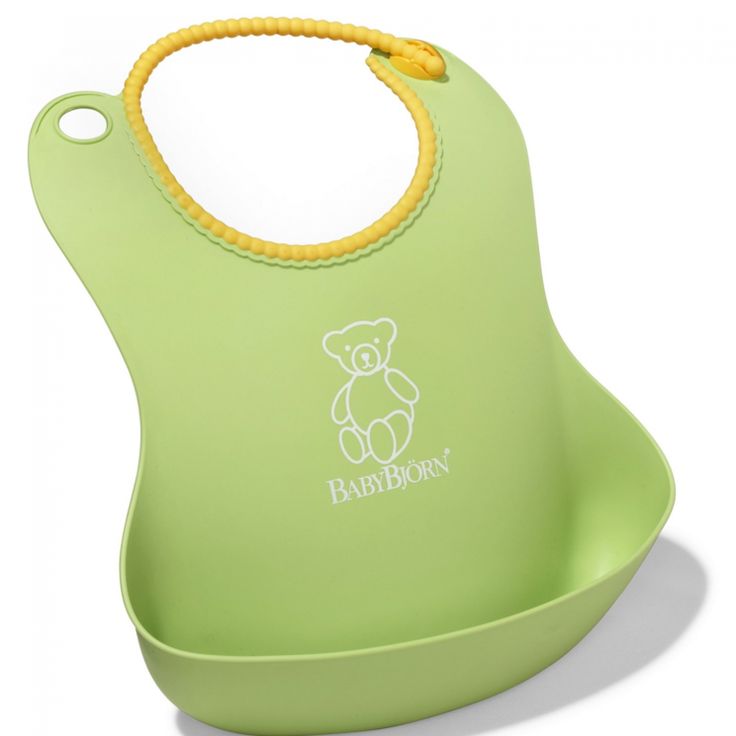 It is necessary to acquaint the child with solid food no earlier than 6-7 months. At this time, the desire to scratch the gums, ready for the appearance of the first teeth, will coincide with the interest in adult food.
It is necessary to acquaint the child with solid food no earlier than 6-7 months. At this time, the desire to scratch the gums, ready for the appearance of the first teeth, will coincide with the interest in adult food.
Dry initial milk formula adapted by Valio Baby 1 NutriValio for feeding children from birth to 6 months Read more
Follow-up dry milk formula adapted by Valio Baby 2 NutriValio for feeding children from 6 to 12 months More
Dry milk drink "Baby milk" Valio Baby 3 NutriValio for feeding children over 12 months Read more
Children are born with a vital, unconditioned reflex - sucking. They are ready to suck on their mother's breasts, but all solid objects that have fallen into their mouths are automatically pushed out so as not to choke (a protective reflex is triggered).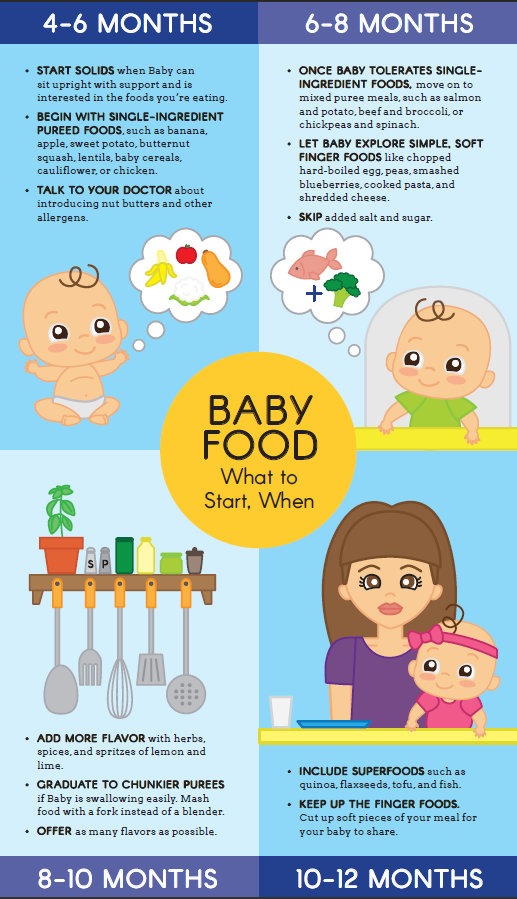 Therefore, parents are not recommended to accustom the baby to solid foods too early. This will cause not only rejection, but sometimes vomiting. The ideal time is considered to be the start of complementary foods. When the first teeth begin to grow in the child, you can replace the homogenized puree with food with the addition of soft fibers. They will be to the taste of the baby, as they will massage itchy gums. An important clue for parents is also the child's interest in adult food. If the baby looks into your plate, tries not to suck on mashed potatoes in a spoon, but to remove it with his upper lip and chew - it's time to introduce more solid food into the children's menu. First, at the tip of the spoon, offer the baby vegetable and cereal side dishes, closer to 9months you can give pieces of well-boiled meat. The kid does not immediately learn to chew them, and the food will come out with a stool almost in its original form. It's not scary, over time the child will learn everything.
Therefore, parents are not recommended to accustom the baby to solid foods too early. This will cause not only rejection, but sometimes vomiting. The ideal time is considered to be the start of complementary foods. When the first teeth begin to grow in the child, you can replace the homogenized puree with food with the addition of soft fibers. They will be to the taste of the baby, as they will massage itchy gums. An important clue for parents is also the child's interest in adult food. If the baby looks into your plate, tries not to suck on mashed potatoes in a spoon, but to remove it with his upper lip and chew - it's time to introduce more solid food into the children's menu. First, at the tip of the spoon, offer the baby vegetable and cereal side dishes, closer to 9months you can give pieces of well-boiled meat. The kid does not immediately learn to chew them, and the food will come out with a stool almost in its original form. It's not scary, over time the child will learn everything. It is important not to ignore his desire, you will have to pay for the pedagogical miscalculation and literally teach the child to chew.
It is important not to ignore his desire, you will have to pay for the pedagogical miscalculation and literally teach the child to chew.
Of course, not everything can go according to plan. The most common reasons why a child refuses solid food:
-
The pieces of food are too big.
-
You are using the wrong feeding technique.
-
The spoon is big for a child.
-
The child has unpleasant associations - perhaps you gave him medicine from this spoon. Do not use everyday baby utensils for unpleasant procedures.
-
The child is in a bad mood or does not feel well.
In no case do not force the baby to eat if he refuses. Gently try again and again. Set an example - eat the first spoon yourself, showing the crumbs how tasty his food is. If the child still cannot cope with solid food, it is worth contacting a pediatric osteopath. The baby may have a non-standard structure of the maxillofacial system, subluxation of the jaw associated with birth trauma, problems with muscle tone. The timely introduction of solid food is very important not only for the full nutrition of the child, it affects his future speech activity. Breastfeeding is a good prevention of speech therapy problems. In order to suck milk from the breast, the child needs to make more efforts than when feeding from a bottle - this is a good (and what is valuable - natural) training of the jaws and muscles of the tongue, and it must be continued by introducing the crumbs to solid food in time. Of course, a baby with a piece of an apple in his hands (and in his mouth) must be looked after so that he does not choke. By the way, for the development of the chewing and speech apparatus, it is useful to grimace with the baby during the game - this strengthens the facial muscles well.
The baby may have a non-standard structure of the maxillofacial system, subluxation of the jaw associated with birth trauma, problems with muscle tone. The timely introduction of solid food is very important not only for the full nutrition of the child, it affects his future speech activity. Breastfeeding is a good prevention of speech therapy problems. In order to suck milk from the breast, the child needs to make more efforts than when feeding from a bottle - this is a good (and what is valuable - natural) training of the jaws and muscles of the tongue, and it must be continued by introducing the crumbs to solid food in time. Of course, a baby with a piece of an apple in his hands (and in his mouth) must be looked after so that he does not choke. By the way, for the development of the chewing and speech apparatus, it is useful to grimace with the baby during the game - this strengthens the facial muscles well.
2.71 7
FoodShare:
Ivargizova Oksana
Medical Institute. Pavlova, specialization - pediatrics
Pavlova, specialization - pediatrics
Author: Reetta Tikanmäki
Palm oil in baby food
Infant milk formulas are made from cow's milk. However, in terms of fat composition, it differs significantly from that of the mother.
Read
Author: Ivargizova Oksana
How to choose milk formula for a baby
Breast milk is the best food for a newborn baby. It contains all the necessary nutritional components that fully meet the needs of the child and are necessary for his healthy and harmonious development.
Read
Show all
Password recovery
To recover your password, enter your e-mail, which you specified during registration.




